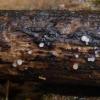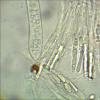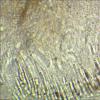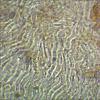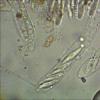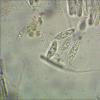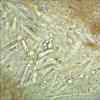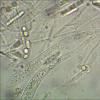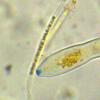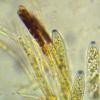
26-12-2025 21:19
Arnold BüschlenPithyella challaudii Pirou. Ist als Bryoparasit in

24-12-2025 17:08
Hulda Caroline HolteHello, I have found this propoloid ascomycete on

21-12-2025 09:32
Hello.A tiny ascomycete found embedded in wood in

21-12-2025 21:32
Pol DebaenstHello, Garden, Burgweg 19, Veurne, BelgiumOn 10/1

22-12-2025 23:38
Patrice TANCHAUDBonsoir, récolte sur un mur en pierre, apothéci

found yesterday near Stuttgart (Ludwigsburg-Poppenweiler, "Zipfelbachtal") on a twig of deciduous wood (likely Fraxinus).
The asci are without crozieres, 8-spored, and IKI-positive (blue, Calycina-type). The paraphyses and the marginal cells of the excipulum contain very conspicuous vacuolar bodies. The spores are multiguttulate when alive, about 21-26/5,5-7 µm large. subfusiform. The excipulum is of prismatic cells with interspace.
Can somebody provide me with a hint?
Regards and best wishes for 2016 to everybody,
from Lothar

I have no idea yet. How large atre the apos or how thick the branch? Fraxinus is quite easily recognizable.
Allophylaria macrospora could be a possibility although the partly larger oil drops are irritating.
A photo of the apical ring in IKI (in the dead state) could be helpful. Are the apos short-stalked?
Zotto

Hi Zotto,
thank you very much for your first opinion. I will do a dead stain of the ascus tomorrow - unfortunately today I won`t have time any more. But I have kept the material alive in a box. For the moment I add two fotos of the IKI in living ascus apices.
Allophylaria could be a good idea in fact. The apothecia (small, I guess about 0,5 mm when larger) have very short but distinct stalks.
Best regards from Lothar

... I forgot: the branch is quite thin, a bit more than 1 cm thick.
Regards Lothar

... and: the spore-drops are confluent to large bodies when they die (what else should they do ....) and in most spores I saw (especially in turgescent asci) they contained only small to very small guttules. The spores in the one picture may have begun to degrade already ...
Regards Lothar


